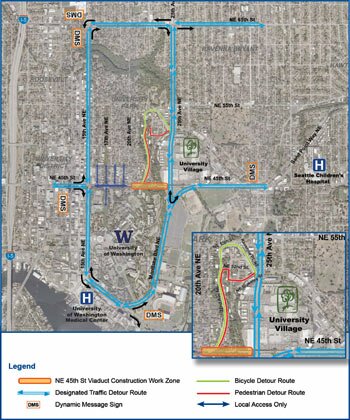 This is SDOT's hilariously small detour map, perhaps trying to mask the miles involved.
This is SDOT's hilariously small detour map, perhaps trying to mask the miles involved.
This is a different viaduct, but its repair is also going to cause significant traffic disruption. The North 45th Street Viaduct is a bridge extending east of the University of Washington, down the hill to the University Village. It's a major thoroughfare, giving communities to the east I-5 access, and of course channeling shoppers right to the U Village.
SDOT is closing the bridge entirely from June 14 (after UW commencement) to September 10. They'll be working as fast as possible, from 7 a.m. to 11 p.m., and perhaps later, because they need to get this project done before the 15th Avenue NE repaving project, running from Pacific Avenue NE to NE 55th Street, starts up in 2011. (15th Avenue NE is a major element in the Viaduct detour plan.)
Constructed in 1938, the Viaduct carries over 20,000 cars each day, on average. SDOT has determined that the 468-foot west approach has reached the end of its safe lifespan (the east approach has already been retrofitted). They're replacing the wooden timbers with a different support to make the bridge significantly stronger, but otherwise, the $30-million repair won't change the current traffic flow: two westbound lanes, one eastbound lane, a pedestrian walkway.
SDOT's FAQ (updated last in March) says traffic will be detoured to Pacific Avenue to the south and 65th to the north (see map). There is no easy way around this: "SDOT is still considering how to direct regional traffic on Interstate‐5 trying to reach specific destinations such as Seattle Children's Hospital, the University of Washington, or University Village." Metro's bus #25 and Seattle Children's Hospital and UWMC shuttles will have to be rerouted. As of March, SDOT did not anticipate any closures to the Burke-Gilman Trail.
There is only one thing to say about the detour routes: Yikes! The south detour especially, taking Pacific to Montlake (or vice versa) will take years off your life during commute times. Essentially, just one more reason why I don't travel north of the Montlake Cut. My condolences if you live there.
 The SunBreak opened its doors back in September. Since then, over 26,000 people have made 40,000 visits to The SunBreak, with over 80,000 page views served. Who's our typical reader? Quantcast says you're most likely an affluent, older man with a graduate degree and no kids at home, who may also be Asian. (Hello, Volvo and Subaru! You can start running ads in 3...2...) That's what we get for writing long. The kids, they won't scroll down that far.
The SunBreak opened its doors back in September. Since then, over 26,000 people have made 40,000 visits to The SunBreak, with over 80,000 page views served. Who's our typical reader? Quantcast says you're most likely an affluent, older man with a graduate degree and no kids at home, who may also be Asian. (Hello, Volvo and Subaru! You can start running ads in 3...2...) That's what we get for writing long. The kids, they won't scroll down that far.
As an online magazine, we have focused mainly on writing our own stories. We have spoken with the guys suing the Sonics, CEO Garrison Bliss of Seattle's innovative healthcare provider Qliance, King County Metro's Kevin Desmond, Redfin's Matt Goyer on iPhone real estate apps, author Derek Johnson about the 2000 Huskies, documentarian Jen Marlowe about Sudan, Jordin Kare about space elevators, weather forecaster and cold-caser Parella Lewis, Michael McCarthy about online health journalism, and researcher George Divoky about global warming and the black guillemot.
On the arts and culture beat, we had conversations with photographer Jenny Jimenez, filmmaker Melvin Peebles, ex-footballer and current one-man-shower Bo Eason, set designer Etta Lillienthal on working in theatre and film, jazz composer Andrew Boscardin, the Satori Group's Andrew Lazarow, Argentine choreographer Diana Szeinblum, Jason Hortin of Hubbard Street Dance, Reggie Watts and Tommy Smith, The Purrs, Mikeah Ernest Jennings on racial comfort zones, Paris Hurley, Norman Bell on subprime theatre, Greg Lundgren, Marissa Niederhauser, and singer-songwriters Kristen Ward and Ali Marcus.
We also went to the Elwha River, Forks, Montesano, Alaska, and (sort of) Iceland.
And now, for the stats geeks, 40 percent of our visits involved a Firefox browser versus 34 percent Internet Explorer. Almost twenty percent were Safari, and almost five percent were Chrome. But don't take it so hard, Microsoft: 65 percent of those visits were on a Windows machine, while 30 percent were Macs. (Over three percent were iPhone visits!) Cable, at 40 percent of visits, had a commanding lead over DSL, at twenty percent.
Here's to the next three months. Come back soon!
Most Viewed Stories
Top Rated Stories
- Andy Warhol Has a Checklist: "love fear pleasure lust pain glamour death" at SAM
- On KT Niehoff, Amelia Reeber, Dance Critics, and Why Glimmer's Worth Seeing
- Seattle Opera Serves Up a Hot, Transcendental Mess
- The Antlers and Phantogram's Cinco de Mayo Fiesta [Photo Gallery]
- What's Really at Stake With the Opening of New Century Theatre's New Show

Most Recent Comments